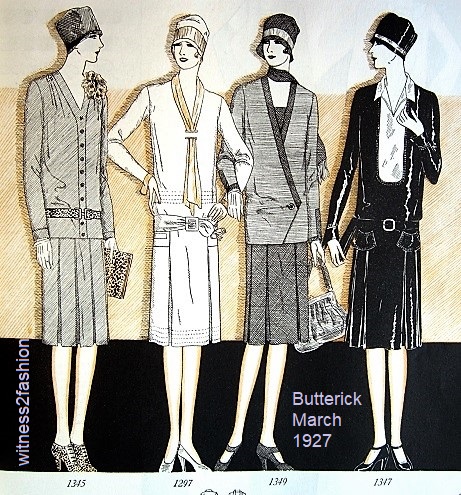
Dresses for women; Butterick’s Delineator magazine, March 1924, p 27.
When we speak of “the Twenties,” most of us are picturing the short skirts and dropped waists of the later 1920s:

Two Butterick pattterns for women, March 1927.
But during the immediate post-war Twenties, women’s clothing actually became longer, although less bulky and more revealing of the body under the clothes.
These dresses are from 1918, the year the war ended. One has a slightly dropped waist:

Dresses, skirts and blouses, Butterick patterns in Delineator magazine, July 1918, page 52.
And these — 6 years later — are from 1924:

Butterick patterns for women, Delineator magazine, March 1924, page 27.
A reaction to the trauma of the First World War created “the Lost Generation” as described by Fitzgerald (in The Great Gatsby, published in 1925) and Hemingway (in The Sun Also Rises, published in October 1926.) Both were writing in the post-war period from 1924 to 1926. Fashions from those years may not look like “the Roaring Twenties” as we often imagine them.

Left, a draped dress from March 1927 which looks very “Twenties” to a modern eye; right, a draped dress from March 1924 — just three years earlier. Both are Butterick patterns featured in Delineator.
Which changed first: the fashions, or the women?

Less formal clothing from 1927, left, and from 1924, right. Butterick patterns from Delineator. What a difference three years made!
More fashion contrasts from March 1924 and March 1927:

Butterick patterns for young women, March 1924. Delineator, page 29.

Clothes for young women and teens; Butterick patterns from March 1924. Delineator, page 29.
Clothes for young women and teens were usually a bit shorter than those for mature women, but not nearly as short as these adult styles from just three years later:

Buttterick patterns from Delineator, March 1927, page 22.

Butterick patterns for women, March 1927.
If you want more details about those eight dresses from 1927, click here.
These youthful outfits from 1924 look fussy and rather stodgy, compared to the streamlined styles of 1927.

Butterick patterns for teens and small women, March 1924. Delineator.

Three styles for teens, Butterick March 1927. [The illustration on the left is bizarrely elongated….]

A coat (1318) and dress (1323) from Butterick patterns, March 1927. Delineator, page 25. They’re like shingled hairstyles: short and sleek.

It’s really useful to see these side-by-side. I think a lot of people don’t realize how much fashion changed year-by-year back then; I saw an online commenter who thought because he can “still wear things from 10 years ago, and they don’t look out of fashion” that means people years ago felt the same. By contrast, a 1935 Dorothy Sayers novel includes a scene in which people are expected to identify a dress based on its having sleeves from a couple years before. Does anyone have more theories on why this is? One reason is the rise of cheaper mass-produced clothing, but I don’t think that can be the only explanation. I remember one article musing that, because technology now changes so much, other design elements don’t, because it would be too jarring. However, there were so many technological advances in the early 20th century that I’m not sure this theory works.
The Sayers reference (I recently re-read Gaudy Night!) reminds me that I occasionally find Butterick patterns for sleeves — for updating your dresses! I’ll try to post some.
In the long run, drastic changes in women’s clothing may be only datable by changes in technology — e.g., the fairly stiff lined/bonded knits of the 1960s, the fluid, drape-y knits of the 1970s, Spandex workout clothing, and the stretch knits that now make mass produced clothing possible by eliminating the need for darts or other traditional fitting techniques. We certainly can’t depend on changes in hem lengths, in our “any length goes” decades. I do notice that leggings used to be worn only with tunics over the torso, and now I see them in public without a hip-length-or-longer covering.
Oh, I wore leggings in the mid-1980’s with a Hawaiian shirt knotted at the waist over them; that seems shorter than what you’re describing? (My body was different then.) But your point about sewing/fabric technology is a good one.
Yes, that was “Gaudy Night” I was alluding to! I just came across another reference to rapid fashion changes in Chapter 30 of Sinclair Lewis’ “Ann Vickers” (1933, but the passage is set in 1925): he describes the main character as a random passerby would have seen her: “Her suit was certainly two years old.” Apparently random passersby were able to judge this with ease in 1925.
Isn’t it wonderful when a book you’re reading for some other purpose sheds light on fashion? I guess the woman in “Ann Vickers” had not shortened her early 20’s skirt…. Thanks for the memory about the 1980s. I remember being in a grocery checkout line in the late 70s or early 80s; the woman next to me had come from her aerobics class and was wearing a leotard, leggings, and legwarmers. I remember thinking that, if the theory about leisurewear gradually becoming business dress was correct, we’d be seeing such revealing work-out clothes worn in stores and restaurants in the future. It happened.